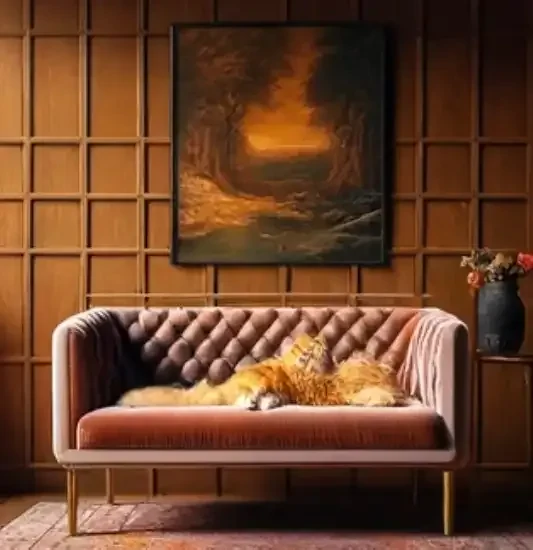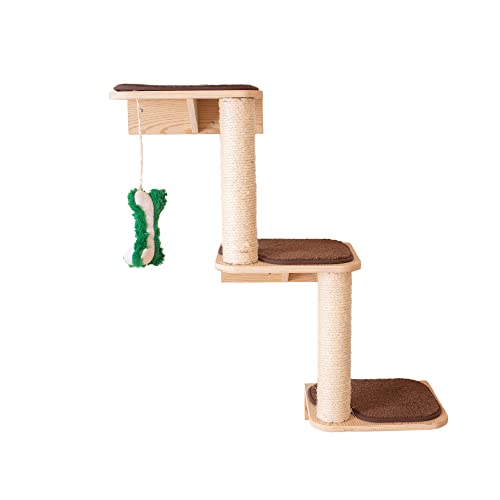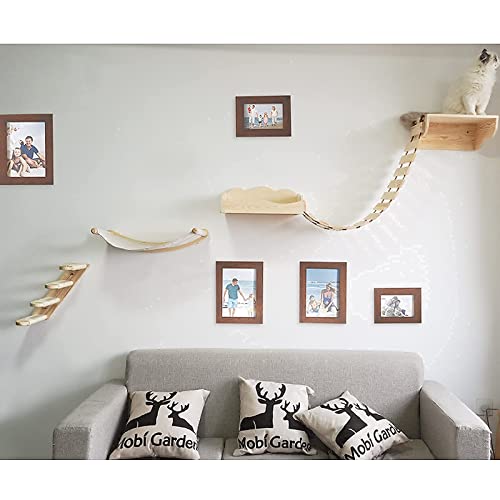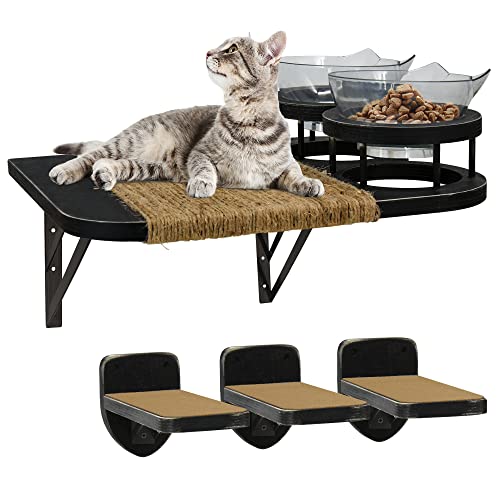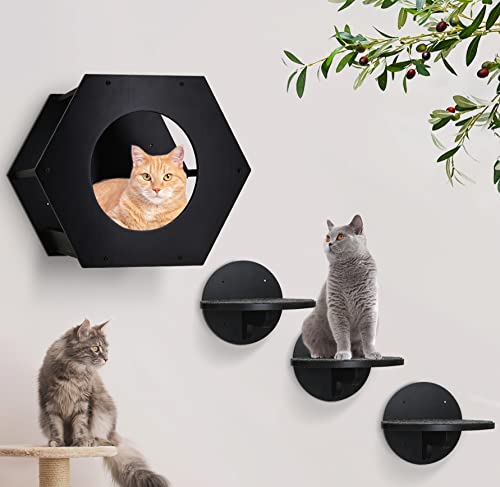Imagine stepping into a home, not just any home, but one meticulously crafted for feline sensibilities. Sunbeams stream through windows, warming a cat as it stretches languidly on a multi-tiered cat tree. A gentle breeze carries enticing scents from a nearby catnip plant. Puzzle toys lie scattered, hinting at recent playful hunts. This is the epitome of a purrfect cat environment – a space that caters to their every need, instinct, and whim. Now contrast this with another image: a cat pacing restlessly in a sparse apartment, batting at dangling cords out of sheer boredom, and retreating under a bed at the slightest noise. The difference is stark, highlighting the profound impact our homes have on our feline companions. Creating the right home environment is not merely about aesthetics or convenience; it’s fundamentally about ensuring the physical, mental, and behavioral well-being of our cats. A thoughtfully designed space fosters physical health by encouraging exercise, providing safety from hazards, and maintaining hygiene. It nurtures mental health by offering stimulation, reducing boredom and stress, and satisfying their innate curiosity. Crucially, it positively impacts behavioral health, minimizing problem behaviors that often stem from environmental deficiencies, like destructive scratching or anxiety-related issues. Beyond these individual benefits, crafting a purrfect cat environment strengthens the very bond we share with our feline family members. A happy, stimulated cat is a more engaged and affectionate companion, enriching our lives in countless ways. This article will be your comprehensive guide to designing such a home, a haven that resonates with your cat’s natural instincts and needs. We will journey through the essential zones within your home, explore the transformative power of vertical space, delve into the realm of sensory enrichment, prioritize household safety, and consider the unique dynamics of multi-cat households. Our ultimate aim is to equip you with the knowledge and inspiration to create an environment where your cat thrives, leading to a happier, healthier, and more harmonious life together.
To truly understand how to create the ideal cat environment, we must first appreciate the fundamental needs that drive their behavior and shape their environmental requirements. Cats, despite domestication, retain a strong connection to their wild ancestors and their ingrained instincts. At the core of these instincts is the hunting or prey drive. Even the most pampered housecat harbors the innate desire to stalk, chase, pounce, and “capture” prey. Providing outlets for this drive, even in a playful context, is crucial for their mental and physical well-being. Scratching is another fundamental behavior, serving multiple purposes beyond just claw maintenance. It's a vital form of territory marking, a way to leave both visual and scent signals for other cats. It also allows them to stretch their muscles and relieve stress. Understanding this instinct is key to redirecting scratching away from your prized furniture and towards designated scratching surfaces. Cats are natural climbers and vertical explorers. In the wild, climbing trees provides vantage points for hunting, escape routes from predators, and a way to survey their territory. This innate love for heights translates directly into their domestic environment. Providing vertical space is not just about aesthetics; it’s about fulfilling a deeply ingrained need for elevated perspectives and secure high perches. Equally important is their need for hiding and retreating. Cats, even confident ones, require safe, private spaces where they can feel secure, observe their surroundings without being seen, and escape from perceived threats or overwhelming stimuli. These safe havens are essential for managing stress and promoting a sense of control in their environment. Finally, cats are inherently territorial creatures. They need to establish and control their territory, even within the confines of your home. This territoriality influences how they interact with their environment and with other cats, particularly in multi-cat households. Beyond these instinctual behaviors, safety and security are paramount. A cat’s environment must be free from hazards. Household dangers such as toxic plants, exposed electrical cords, and easily accessible cleaning chemicals pose significant risks. A safe environment also encompasses a sense of predictability and control. Cats thrive on routine and appreciate the ability to retreat and observe their surroundings from a safe distance. Minimizing environmental stressors, such as sudden loud noises or chaotic disruptions, is crucial for their well-being. Beyond fulfilling basic needs and ensuring safety, creating a perfect cat environment involves providing ample physical and mental stimulation. Boredom in cats can manifest in various negative ways, from destructive scratching and excessive vocalization to depression and lethargy. A stimulating environment combats boredom, encourages exercise, and promotes mental engagement. Interactive play, puzzle feeders, and opportunities to explore and investigate keep their minds active, preventing stagnation and fostering a sense of fulfillment.
Within your home, strategically creating distinct zones dedicated to different aspects of your cat’s life is fundamental to a well-designed environment. Let's begin with the feeding zone, the heart of nourishment and, surprisingly, also hygiene. The placement of food and water bowls is more critical than you might think. Opt for quiet, low-traffic areas where your cat can eat undisturbed. Crucially, keep food and water bowls separate from litter boxes to maintain hygiene and appeal. Cats, with their refined senses, are unlikely to appreciate dining near their elimination area. The type of bowls also matters. Shallow, wide bowls are often preferred by cats as they prevent whisker fatigue, a condition caused by whiskers constantly brushing against the sides of deep, narrow bowls, which can be surprisingly irritating. Material considerations are also important; ceramic and stainless steel are generally hygienic and easy to clean. Water is just as vital as food, and encouraging hydration is paramount for feline health. Consider offering water in multiple locations and in different forms. Some cats prefer water fountains, which provide fresh, moving water and can be more appealing than still water in a bowl. Whether you choose bowls or fountains, ensure water sources are readily accessible and kept fresh daily. Hygiene within the feeding zone extends beyond just fresh water and clean bowls. Regularly wash food and water bowls to prevent bacterial buildup. Be mindful of potential food contamination, especially with wet food left out for extended periods. If pests are a concern, take steps to control them in the feeding area without using harmful chemicals that could be ingested by your cat. To further enhance the feeding experience and provide mental enrichment, consider incorporating puzzle feeders and slow feeders. Puzzle feeders challenge your cat to work for their food, stimulating their problem-solving skills and slowing down eating, which can be beneficial for digestion and weight management. Slow feeders, designed to extend meal times, can also help prevent gulping and overeating.
Moving on to the elimination zone, litter box logistics and preferences are paramount for both your cat’s comfort and your household harmony. Litter box placement is once again key. Choose locations that are quiet, easily accessible, and offer a degree of privacy. Just as you wouldn’t want to eat in the bathroom, neither does your cat want their litter box in the middle of a busy thoroughfare. Avoid placing litter boxes in noisy or high-traffic areas. Locate them away from food and water bowls, in areas where your cat feels safe and undisturbed. In multi-cat homes, the rule of thumb for litter boxes is "one more box than the number of cats." This helps prevent competition for resources and ensures all cats have ample access to clean elimination areas. Strategically place these boxes throughout your home, not just clustered together, allowing each cat to establish their preferred locations. The type of litter box itself is another important consideration. Open litter boxes are generally preferred by cats as they offer better ventilation and visibility, allowing them to feel less confined. However, covered litter boxes can help contain odors and litter scatter, which might be preferable for some owners. Self-cleaning litter boxes offer convenience but can be costly and may not be suitable for all cats, especially those sensitive to noise or sudden movements. Consider the size and depth of the litter box. It should be large enough for your cat to comfortably turn around and eliminate without feeling cramped, and deep enough to accommodate an adequate amount of litter. The type of litter is a deeply personal preference for both cats and their owners. The options are vast, ranging from clumping to non-clumping, clay, crystal, paper, and plant-based litters. Clumping litter is popular for its ease of scooping, while non-clumping litter requires more frequent full changes. Clay litter is traditional and often affordable, but can be dusty. Crystal litter is known for odor control, while paper and plant-based litters are often chosen for their eco-friendliness. Ultimately, consider your cat’s preferences and any sensitivities they might have, along with your own convenience and odor control needs. Hygiene and maintenance are non-negotiable aspects of litter box management. Scooping should be done daily, or even twice daily in multi-cat households, to remove waste and maintain a clean environment. Regularly perform complete litter changes, typically weekly or bi-weekly depending on the type of litter and number of cats, to remove accumulated urine and bacteria. Clean the litter box itself with soap and water (avoid harsh chemicals or heavily scented cleaners) during litter changes. Implement odor control strategies, such as using odor-absorbing litter, litter box liners, or placing the box in a well-ventilated area. Consistency is key in litter box maintenance. Cats are creatures of habit, and consistent cleaning routines help maintain a positive elimination environment and prevent litter box aversion issues.
Next, we move to the scratching zone, a critical area for satisfying a cat’s natural scratching instincts while protecting your furniture. Understanding the importance of scratching is the first step. It’s not simply about sharpening claws; scratching serves essential biological and behavioral needs. It helps maintain claw health by shedding the outer layers, it’s a vital form of territory marking, both visually and through scent glands in their paws, it’s a way to stretch their muscles, and it serves as a stress reliever. Providing appropriate scratching surfaces is not just about saving your sofa; it’s about fulfilling these fundamental needs. The types of scratching posts available are diverse. Vertical posts are the most common, mimicking trees that cats naturally scratch in the wild. Horizontal scratchers, often made of cardboard, are also popular and cater to cats who prefer scratching on horizontal surfaces. Materials vary widely, from cardboard to sisal, carpet, and wood, each offering a different texture and level of resistance. Experiment with different types to discover your cat’s preferences. Placement of scratching posts is strategic. Locate them near your cat’s sleeping areas, as cats often scratch upon waking up to stretch. Place them in play areas to integrate scratching into their active routines. Crucially, place scratching posts near furniture they might be tempted to scratch. This proximity provides an appealing alternative and redirects their scratching behavior to the appropriate surfaces. Consider placing posts near entry and exit points of perceived territories to allow for territorial marking. Encouraging scratching on appropriate surfaces involves a combination of positive reinforcement and deterring scratching on inappropriate surfaces. Praise and reward your cat when they use the scratching post with treats or affection. You can also use catnip or pheromone sprays to attract them to the scratching post and make it more enticing. To make inappropriate surfaces less appealing, consider using double-sided tape, which cats generally dislike the sticky texture of, or scent deterrents specifically designed for cats, sprayed on furniture to discourage scratching.
The play and hunting zone is where you provide enrichment and exercise, tapping into your cat’s innate predatory instincts. The importance of play cannot be overstated. It’s not just fun for your cat; it’s essential for simulating hunting behavior, providing crucial physical and mental exercise, strengthening the bond between you and your cat, and preventing boredom. The types of toys that can be incorporated into the play zone are limitless. Interactive toys, such as wand toys, feather wands, and laser pointers (used responsibly and never directed into the eyes), are fantastic for engaging your cat in active play and mimicking prey movements. Puzzle toys challenge their problem-solving skills and provide mental stimulation. Solo play toys, like balls, toy mice, and crinkle balls, offer independent entertainment when you're not available for interactive play. Rotate toys regularly to maintain your cat’s interest and prevent toy fatigue. Interactive play sessions should be a regular part of your daily routine. Aim for at least 10-15 minutes of focused play sessions once or twice a day, or broken up into shorter bursts throughout the day. Mimic prey movements during play sessions, moving toys like a mouse would – scurrying, hiding, and darting – to engage their hunting instincts. End play sessions appropriately, allowing your cat to “catch” and “capture” the toy at the end, providing a sense of accomplishment and satisfaction, rather than abruptly ending the chase. Puzzle feeders, as mentioned earlier, can also double as enrichment tools within the play zone, combining feeding and play in a stimulating way. Vertical play spaces, integrating climbing structures and perches into play areas, further enhance the hunting and play experience, allowing cats to stalk and pounce from elevated vantage points, mirroring their natural hunting behaviors.
Finally, we arrive at the resting and sleeping zone, the sanctuary where your cat seeks safe havens and comfort. Providing a variety of sleeping spots is key to catering to your cat’s preferences. Offer options for different moods and temperatures, such as sunny spots for basking, cozy corners for snuggling, enclosed beds for security, and elevated perches for observation and a sense of safety. Comfortable bedding is paramount. Soft blankets, cushions, and cat beds of various shapes, sizes, and materials offer options for different preferences. Consider temperature preferences as well. Heated beds can be particularly appealing in colder months, while cooling beds might be appreciated in warmer weather. Ensure some sleeping areas are located in quiet and undisturbed locations, away from high traffic areas and excessive noise, providing a peaceful retreat. Safety and security are vital, even in sleeping zones. Ensure elevated sleeping spots, such as cat trees or shelves, are stable and secure to prevent falls. Avoid placing beds near sharp edges or other potential hazards.
Vertical space is not just an aesthetic addition to your cat environment; it's a fundamental element that taps into their evolutionary instincts and significantly enhances their well-being. The reason cats are so drawn to vertical space is deeply rooted in their evolutionary history. From a predator/prey perspective, elevated positions provide a vantage point to survey their territory, spot potential prey, and also detect approaching predators. This instinct translates directly to their domestic environment. Vertical space offers a sense of security, a feeling of being in control of their surroundings, and observation points from which to survey their domain. Creating vertical opportunities in your home can be achieved in numerous ways. Cat trees and condos, in a variety of sizes, styles, and features, are the most common and effective way to introduce vertical space. Strategically place them near windows, in living areas, or in quiet corners, providing different vantage points and activity hubs. Shelves and wall-mounted perches offer more customizable vertical solutions. DIY options, using brackets and planks, or pre-made cat shelves allow you to create climbing pathways and routes tailored to your space and your cat’s agility. Window perches and hammocks are particularly appealing as they combine vertical elevation with sunny spots and outdoor views, offering a double dose of feline enjoyment. Don't underestimate the potential of utilizing existing furniture. Arranging bookshelves, cabinets, and other furniture in a way that creates climbing opportunities and access to high places, while ensuring safety, can effectively integrate vertical space into your existing décor. The benefits of vertical territory are numerous and profound. It increases their sense of security, reduces stress by providing escape routes and observational advantages, enhances play opportunities by incorporating vertical elements into their hunting simulations, and it’s a remarkably efficient way to utilize space, especially in smaller homes, by expanding their usable territory upwards rather than outwards. When implementing vertical elements, always prioritize accessibility and safety. Ensure cat trees and shelves are stable and securely mounted. Choose safe heights appropriate for your cat’s age and agility. Provide easy access to higher levels with ramps or steps for older or less agile cats. Avoid sharp edges or other hazards on vertical structures.
Sensory enrichment is the art of engaging all of your cat’s senses to create a stimulating and fulfilling environment. Visual enrichment is often overlooked, but can be incredibly enriching. Window views provide endless entertainment for indoor cats. Position furniture or cat perches near windows, and consider placing bird feeders outside to attract avian entertainment. Views of nature, even just trees and squirrels, are inherently stimulating for cats. Safe outdoor access, such as a catio or screened porch, offers the ultimate visual enrichment, allowing them to experience the sights, sounds, and scents of the outdoors in a controlled and safe way. “Cat TV,” in the form of nature documentaries or fish tank videos played on screens, can also provide safe and appropriate visual stimulation, especially when you are not home to provide interactive play. Auditory enrichment, focusing on sounds, can also be calming and engaging. Calming sounds, such as classical music, nature sounds, or music specifically designed for cats, can create a relaxing and stress-reducing atmosphere. Interactive toys with sound, such as toys that crinkle, chirp, or make other enticing noises during play, further stimulate their hunting instincts. Conversely, minimizing stressful sounds is equally important. Reduce exposure to loud noises, such as excessively loud TV or music, or noisy appliances. Create quiet zones within your home where your cat can retreat from overwhelming sounds. Olfactory enrichment, appealing to their keen sense of smell, can be particularly potent. Catnip and silver vine are well-known cat attractants, using cat-safe plants to stimulate playfulness and relaxation (in moderation). Pheromone therapy, using diffusers or sprays containing synthetic feline facial pheromones like Feliway, can create a calming and secure atmosphere throughout your home. Explore other safe scents that cats often enjoy, such as herbs like valerian or chamomile, introducing them cautiously to gauge your cat’s reaction. Crucially, be mindful of harmful scents. Avoid using strong cleaning products or perfumes around cats. Many essential oils are toxic to cats, so use caution and research thoroughly before introducing any new scents. Ensure good ventilation in your home to disperse any potentially irritating or harmful airborne substances. Tactile enrichment, appealing to their sense of touch, involves providing a variety of textures and opportunities for physical interaction. Offer scratching posts with different surfaces – cardboard, sisal, carpet, and wood – to cater to varied tactile preferences. Provide soft bedding in a variety of materials, such as fleece, plush, and cotton, offering different levels of warmth and texture. Regular grooming sessions are not only essential for coat health but also serve as a valuable form of tactile interaction and bonding with your cat. Consider incorporating safe plants, such as cat-safe grasses or wheatgrass, that your cat can rub against for tactile stimulation, ensuring they are non-toxic and safe for ingestion if nibbled.
Household safety is paramount when creating a perfect cat environment. Cat-proofing your home is not just about preventing damage; it’s about protecting your feline family member from potential hazards. Identifying potential hazards is the first step. Toxic plants are a significant danger. Familiarize yourself with a list of plants toxic to cats, such as lilies, poinsettias, and many others, and remove them from your home or keep them completely out of reach. Cleaning products and chemicals pose a serious risk if ingested or inhaled. Store cleaning products and chemicals securely, out of reach of cats. Avoid using harsh or heavily scented cleaners around cats, and ensure good ventilation after cleaning. Electrical cords and wires are tempting chew toys for some cats, posing electrocution risks. Use cord protectors to cover exposed wires and hide cords whenever possible. Discourage cord-chewing behavior through deterrents and providing appropriate chew toys. Medications, both human and pet, can be extremely toxic if ingested by cats. Store all medications securely, preferably in childproof containers and out of reach. Be aware that common human medications like acetaminophen and ibuprofen are highly toxic to cats. Small objects, such as string, yarn, rubber bands, and small toys, pose a choking hazard or can cause intestinal blockages if ingested. Keep these items stored away and out of reach. Regularly check for and remove any small, potentially ingestible objects from your cat’s environment. Window and balcony safety is crucial, especially for cats living in apartments or multi-story homes. Ensure all windows and balconies are securely screened to prevent accidental falls and escapes. Kitchens and bathrooms, while often overlooked, can also harbor dangers. Be mindful of hot stoves, keep toilet lids closed to prevent accidental drowning, and store cleaning supplies and garbage disposals safely to minimize risks in these areas.
Creating harmony in multi-cat homes requires careful planning and resource management to minimize stress and promote peaceful coexistence. Resource spacing and duplication is paramount. Ensure you provide enough food bowls, water sources, litter boxes, scratching posts, and sleeping areas for each cat to prevent competition and resource guarding. Strategically space these resources throughout your home, avoiding clustering them all in one location. Creating individual territories and zones is particularly important in multi-cat households. In multi-level homes, designate distinct zones for each cat, allowing them to establish their own safe spaces and minimize forced interactions. Even within a single-level home, utilize furniture arrangement and vertical space to create defined areas. Vertical space is even more crucial in multi-cat homes. Cat trees, shelves, and wall-mounted perches provide essential escape routes and reduce face-to-face confrontations by allowing cats to move around the home without constantly crossing paths on ground level. Think of vertical structures as “cat highways,” allowing them to navigate the environment while maintaining comfortable distances. Carefully monitor cat interactions. Observe your cats for signs of stress or conflict, such as hissing, swatting, or avoidance. Intervene appropriately to redirect tense interactions, never punishing a cat for defensive behavior, but rather focusing on separating them and providing more space and resources. If persistent conflict arises, consider providing completely separate resources and living zones for cats who are not compatible. Scent marking and familiarity play a crucial role in multi-cat harmony. Allow cats to establish their scent naturally within their shared territory. While hygiene is important, avoid excessive cleaning of scent markings in multi-cat areas, unless it’s creating hygiene issues, as scent marking is a form of communication and territory establishment for cats.
Maintaining a clean and hygienic environment is essential for your cat’s health and overall well-being. Regular litter box maintenance, as discussed earlier, is paramount, involving daily scooping, regular complete litter changes, cleaning the litter boxes themselves, and implementing odor control measures. Food and water bowl hygiene is equally important, requiring daily washing of food and water bowls to prevent bacterial growth. Provide fresh water daily and avoid leaving wet food out for extended periods. General cleaning, such as regular vacuuming or sweeping, is crucial to remove cat hair and dander, minimizing allergens and maintaining overall cleanliness. Regularly wash cat beds and blankets to remove dander, hair, and potential parasites. Spot clean any accidents promptly and thoroughly using pet-safe cleaning products. When cleaning your cat’s environment, always use pet-safe cleaning products, avoiding harsh chemicals or heavily scented cleaners that could be irritating or toxic to cats. Implement pest control measures, such as flea and tick prevention, as recommended by your veterinarian. Maintaining a clean environment also helps minimize pests and associated health risks.
Creating the perfect cat environment is achievable regardless of your home size or budget. In small apartments, maximizing space is key. Vertical space becomes even more crucial in limited square footage. Utilize cat trees that are tall but have a smaller footprint, and install wall-mounted shelves to expand their usable territory upwards. Multi-functional furniture, such as coffee tables that double as cat beds or storage ottomans that incorporate scratching posts, can be particularly helpful in small spaces. Cat furniture and enrichment elements can be integrated into various home décor styles. Stylish cat trees, discreet litter box enclosures that blend with your furniture, and DIY solutions crafted from materials that complement your aesthetic preferences allow you to create a cat-friendly environment without compromising your home’s design. Creating a purrfect cat environment doesn't have to break the bank. Budget-friendly options are readily available. DIY cat furniture, using repurposed cardboard boxes or upcycled materials, can be a cost-effective solution. Repurposing household items, such as turning old sweaters into cat beds or using sturdy cardboard tubes as scratching posts, further reduces costs. Affordable toy options abound, from simple ping pong balls to inexpensive wand toys. When on a tight budget, prioritize key elements – litter boxes, scratching posts, and basic food and water bowls – focusing on functionality and hygiene, and gradually add more enriching elements as your budget allows.
In conclusion, creating the perfect cat environment is an ongoing journey, a continuous process of observation, adaptation, and refinement. By carefully considering the essential zones, harnessing the power of vertical space, engaging their senses through enrichment, prioritizing household safety, and fostering harmony in multi-cat homes, you are laying the foundation for a truly feline-friendly abode. Remember that the benefits extend far beyond a well-decorated home. A thoughtfully designed cat environment translates directly into a happier, healthier cat, a reduction in stress-related behavioral issues, and a deeper, more fulfilling bond between you and your feline companion. Creating this purrfect space is not just about fulfilling their needs; it’s an act of love, a testament to the joy and enrichment that cats bring to our lives. And as you witness your cat thriving in their thoughtfully crafted domain, you'll understand that this labor of love yields immeasurable rewards, enriching your life as much as theirs, fostering a truly harmonious and joyful coexistence with your feline family member.
